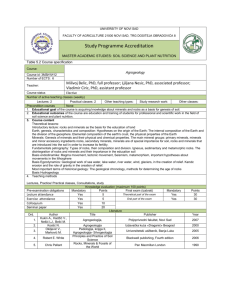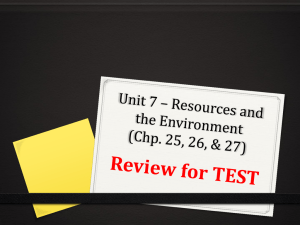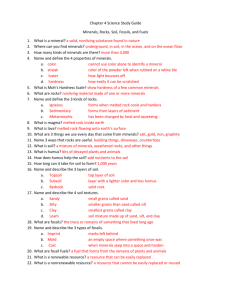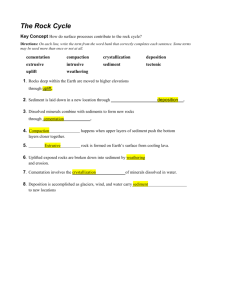trace elements
advertisement
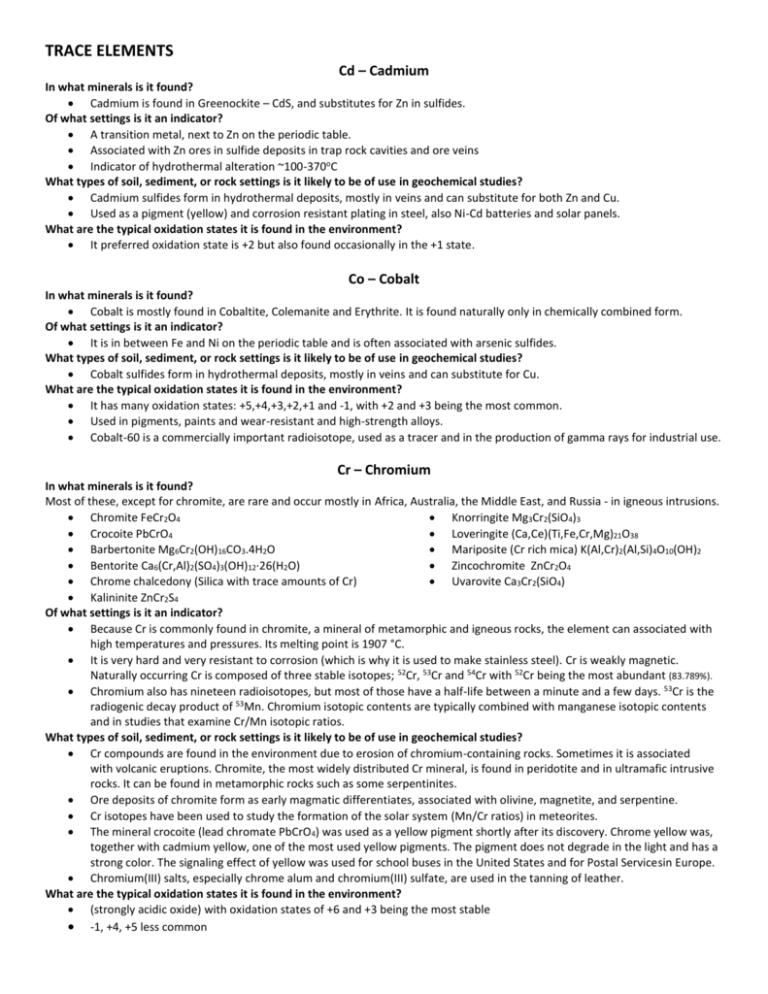
TRACE ELEMENTS Cd – Cadmium In what minerals is it found? Cadmium is found in Greenockite – CdS, and substitutes for Zn in sulfides. Of what settings is it an indicator? A transition metal, next to Zn on the periodic table. Associated with Zn ores in sulfide deposits in trap rock cavities and ore veins Indicator of hydrothermal alteration ~100-370oC What types of soil, sediment, or rock settings is it likely to be of use in geochemical studies? Cadmium sulfides form in hydrothermal deposits, mostly in veins and can substitute for both Zn and Cu. Used as a pigment (yellow) and corrosion resistant plating in steel, also Ni-Cd batteries and solar panels. What are the typical oxidation states it is found in the environment? It preferred oxidation state is +2 but also found occasionally in the +1 state. Co – Cobalt In what minerals is it found? Cobalt is mostly found in Cobaltite, Colemanite and Erythrite. It is found naturally only in chemically combined form. Of what settings is it an indicator? It is in between Fe and Ni on the periodic table and is often associated with arsenic sulfides. What types of soil, sediment, or rock settings is it likely to be of use in geochemical studies? Cobalt sulfides form in hydrothermal deposits, mostly in veins and can substitute for Cu. What are the typical oxidation states it is found in the environment? It has many oxidation states: +5,+4,+3,+2,+1 and -1, with +2 and +3 being the most common. Used in pigments, paints and wear-resistant and high-strength alloys. Cobalt-60 is a commercially important radioisotope, used as a tracer and in the production of gamma rays for industrial use. Cr – Chromium In what minerals is it found? Most of these, except for chromite, are rare and occur mostly in Africa, Australia, the Middle East, and Russia - in igneous intrusions. Chromite FeCr2O4 Knorringite Mg3Cr2(SiO4)3 Crocoite PbCrO4 Loveringite (Ca,Ce)(Ti,Fe,Cr,Mg)21O38 Barbertonite Mg6Cr2(OH)16CO3.4H2O Mariposite (Cr rich mica) K(Al,Cr)2(Al,Si)4O10(OH)2 Bentorite Ca6(Cr,Al)2(SO4)3(OH)12·26(H2O) Zincochromite ZnCr2O4 Chrome chalcedony (Silica with trace amounts of Cr) Uvarovite Ca3Cr2(SiO4) Kalininite ZnCr2S4 Of what settings is it an indicator? Because Cr is commonly found in chromite, a mineral of metamorphic and igneous rocks, the element can associated with high temperatures and pressures. Its melting point is 1907 °C. It is very hard and very resistant to corrosion (which is why it is used to make stainless steel). Cr is weakly magnetic. Naturally occurring Cr is composed of three stable isotopes; 52Cr, 53Cr and 54Cr with 52Cr being the most abundant (83.789%). Chromium also has nineteen radioisotopes, but most of those have a half-life between a minute and a few days. 53Cr is the radiogenic decay product of 53Mn. Chromium isotopic contents are typically combined with manganese isotopic contents and in studies that examine Cr/Mn isotopic ratios. What types of soil, sediment, or rock settings is it likely to be of use in geochemical studies? Cr compounds are found in the environment due to erosion of chromium-containing rocks. Sometimes it is associated with volcanic eruptions. Chromite, the most widely distributed Cr mineral, is found in peridotite and in ultramafic intrusive rocks. It can be found in metamorphic rocks such as some serpentinites. Ore deposits of chromite form as early magmatic differentiates, associated with olivine, magnetite, and serpentine. Cr isotopes have been used to study the formation of the solar system (Mn/Cr ratios) in meteorites. The mineral crocoite (lead chromate PbCrO4) was used as a yellow pigment shortly after its discovery. Chrome yellow was, together with cadmium yellow, one of the most used yellow pigments. The pigment does not degrade in the light and has a strong color. The signaling effect of yellow was used for school buses in the United States and for Postal Servicesin Europe. Chromium(III) salts, especially chrome alum and chromium(III) sulfate, are used in the tanning of leather. What are the typical oxidation states it is found in the environment? (strongly acidic oxide) with oxidation states of +6 and +3 being the most stable -1, +4, +5 less common Cs – Cesium In what minerals is it found? some uncommon types of beryl [Be3Al2(SiO3)6] rhodizite (a hydrated borate) avogadrite [(K,Cs) BF4] most abundant in pollucite* (Cs2Al2Si4O12) *It is estimated that 82% of the world’s Cs reserve base occur at one site, Bernic Lake, Manitoba, Canada, in the form of pollucite. Of what settings is it an indicator? High vapor and water pressure conditions found in cooling intrusive rocks As magma cools, water becomes concentrated in the molten portion of the rock because it does not get incorporated into common minerals that crystallize. The remaining uncrystallized portion of magma is water rich. It is also rich in other elements like silica, lithium and cesium that also do not like to go into ordinary minerals. The crystals tend to nucleate slowly, but high water content plus high vapor and water pressure make it possible for crystals to grow quickly once they nucleate, resulting in the relatively large crystals found in pegmatites. Avogadrite specifically is associated with the sublimination product around volcanic fumaroles. What types of soil, sediment, or rock settings is it likely to be of use in geochemical studies? Cesium-baring minerals are found in very few places in the world in pegmatites and are associated with more commercially important lithium-bearing minerals (lepidolie and petalie) Cs bearing rocks are rare, thus is generally only useful in granitic pegmatites, in areas where we might detect historic magma intrusion and volcanic activity. Although Cs is highly reactive, it does not substitute readily with elements closely associated with it, like rubidium, thus does not occur in the same lower temperature evaporates as rubidium and is not very useful in these environments. Cs is a radioactive gamma-emitter and certain isotopes can be used to date rock or soil profiles. A common radioisotope of Cs, 137 Cs is useful in modern soil and oceanic sediments profiles as a marker. 137 Cs is produced in nuclear bomb blasts. Prior 1963 when the Limited Test Ban Treaty was signed, most bomb testing took place aboveground; after the treaty took effect, bomb testing had to be performed underground. In the year before the ban was enacted, there was a blitz of aboveground testing, creating a peak in global 137 Cs which settled in soils around the globe between 1963 and 1964, creating a robust global marker for measuring soil/sediment horizon development. Relatively few chemical applications exist for cesium. However, because of their high density, solutions of caesium chloride (CsCl), sulfate (Cs2SO4), and trifluoroacetate (Cs(O2CCF3)) are commonly used in molecular biology for density gradient ultracentrifugation. This technology is primarily applied to the isolation of viral particles, sub-cellular organelles and fractions, and nucleic acids from biological samples. What are the typical oxidation states it is found in the environment? • Typical oxidation state: +1 Cu – Copper In what minerals is it found? Cuprite – Cu2O Bornite – Cu5FeS4 Azurite – 2CuCO3CU(OH)4 Chalcocite – Cu2S Malachite – CuCO3Cu(OH)4 Chalcopyrite – CuFeS2 Of what settings is it an indicator? Primary mineralization from hydrothermal fluids passing through mafic lavas (lava with high concentrations of heavy elements such as Mg or Fe). Hydrothermal mid temperature range, varying pressures. Mine-grade Cu is often a cap on copper-sulfide veins; most industrial copper is mined as Cu-sulfides and refined. What types of soil, sediment, or rock settings is it likely to be of use in geochemical studies? Associated with igneous formations, in particular basalts. Often found along with silver, sulfides, calcite, chlorite. Porphyry copper: isolated ore deposit of copper resulting from fractional crystallization of magma largest sources of copper ore, often fills fractures. Soils rich in copper are likely to be found over igneous parent material. What are the typical oxidation states it is found in the environment? Cu (I) – Often found in native ores Cu(II) – Common form as found in copper sulfides or oxides Cu (III) and Cu (IV) – Rare forms Mn -- Manganese In what minerals is it found? Mn is found in many minerals, these are some of the common ones: Mn3+ : Muscovite, Beryl , Piemontite , Andalusite, Tremolite (amphibole), Olivine, Spinels, Garnets… Mn2+ : Rhodonite (pyroxenoid)- (Mn++,Fe++,Mg,Ca)SiO3, Rhodocrosite-MnCO3. Mn4+ : black manganese oxides-MnO2 such as Pyrolusite and Hollandite, Spodumene (pyroxene) , Kunzite-LiAlSi2O6. Found in many minerals substituting for Fe2+ most commonly at any sites in a crystal structure where the metal ions can be accommodated. Of what settings is it an indicator? major elements/impurities in igneous and metamorphic minerals, carbonates and oxides; occurs at any T and P conditions; and high T and P Mn is more likely accommodated in the mineral structures or substituting for Fe2+ for example in the octahedral sites in olivine, spinels, etc.; at lower P-T conditions, it forms carbonates and oxides. In igneous rocks, if they are enriched in Mn, it indicates a more primitive parental melt. In the oceans, it indicates oxidation state as it is dissolved and precipitated as the oxygen levels in the oceans fluctuate (Mnrich layers deposited during reducing conditions, for example). In soil, it most likely is enriched by concentration. What types of soil, sediment, or rock settings is it likely to be of use in geochemical studies? igneous, metamorphic, hydrothermal, and sedimentary Manganese dioxide is used as the cathode (electron acceptor) material in standard and alkaline disposable dry cells and batteries. Manganese is essential to iron and steel production by virtue of its sulfur-fixing, deoxidizing, and alloying properties. The second large application for manganese is as alloying agent for aluminum. Methylcyclopentadienyl manganese tricarbonyl is used as an additive in unleaded gasoline to boost octane rating and reduce engine knocking. Permanganate (+7 oxidation state) compounds are purple, and can give glass a violet color. Manganese compounds have been used as pigments and for the coloring of ceramics and glass. The brown color of ceramic is sometimes based on manganese compounds. In the glass industry manganese compounds are used for two effects. Manganese(III) reacts with iron(II). The reaction induces a strong green color in glass by forming less-colored iron(III) and slightly pink manganese(II), compensating the residual color of the iron(III). Larger amounts of manganese are used to produce pink colored glass. What are the typical oxidation states it is found in the environment? Mn2+, Mn3+ and Mn4+. The Mn4+ is unstable and will be reduced to Mn3+ after a few hours exposure to sunlight. Nb – Niobium In what minerals is it found? Niobium is found in nacareniobsite, nartniobite and columbite among other minerals. Of what settings is it an indicator? A rare, soft, grey, ductile transition metal Is an indicator of igneous processes. Nb is immobile mostly up to the lower amphibolite facies alteration. Found in lowmedium pressure systems. Temperatures can range from 700-1100 C. Columbite is found in granitic pegmatites as an accessory mineral. Can be found as these granitic pebbles in alluvium deposits. What types of soil, sediment, or rock settings is it likely to be of use in geochemical studies? Niobium is used mostly in alloys, the largest part in special steel such as that used in gas pipelines. The temperature stability of niobium-containing superalloys is important for its use in jet and rocket engines. Niobium is used in various superconducting materials/alloys are widely used in the superconducting magnets of MRI scanners. Other applications of niobium include its use in welding, nuclear industries, electronics, optics, numismatics and jewelry. In the last two applications, niobium's low toxicity and ability to be colored by anodisation are particular advantages. What are the typical oxidation states it is found in the environment? It is most commonly found in the +5 oxidation state, but +2, +3 and +4 are also found. Ni – Nickel In what minerals is it found? Limonite (Fe, Ni)O(OH), garnierite (Ni-silicate), pentlandite (Ni, Fe)9S8, nickeline Of what settings is it an indicator? Indicator of ultramafic igneous rocks and is mobilized by low temperature hydrothermal activity Serpentine soil and rock, tropical areas with weathered ultramafic igneous rock (laterites), and the Earth's core! What types of soil, sediment, or rock settings is it likely to be of use in geochemical studies? • The metal is corrosion-resistant, finding many uses in alloys, as a plating, in the manufacture of coins, magnets and common household utensils, as a catalyst for hydrogenation. • Nickel is used in many industrial and consumer products, including stainless steel, magnets, coinage, rechargeable batteries, electric guitar strings and special alloys. It is also used for plating and as a green tint in glass. Nickel is pre-eminently an alloy metal, and its chief use is in the nickel steels and nickel cast irons, of which there are many varieties. What are the typical oxidation states it is found in the environment? Oxidation states: +2 is most common along with Ni(0), but also +1, +3, and +4. Pb – Lead In what minerals is it found? Metallic lead does occur in nature, but it is rare. The main lead mineral is galena (PbS), which contains 86.6% lead. Other common varieties are cerussite (PbCO3) and anglesite (PbSO4). Of what settings is it an indicator? Lead is usually found in ore with zinc, silver and (most abundantly) copper, and is extracted together with these metals. Found in igneous, sedimentary and rocks. Lower temperature hydrothermal settings of Mississippi Valley Type Pb-Zn deposits. What types of soil, sediment, or rock settings is it likely to be of use in geochemical studies? Lead is used in building construction, lead-acid batteries, bullets and shots, ballast keel of sailboats , weights, as part of solders, pewters, fusible alloys and as a radiation shields. Sulfide ores are roasted, producing primarily lead oxide and a mixture of sulfates and silicates of lead. Due to its half life of 22.2 years the radioactive isotope 210Pb is used for dating material from marine sediment cores by radiometric methods. The low melting point makes casting of lead easy, and therefore small arms ammunition and shotgun pellets can be cast with minimal technical equipment. It is also inexpensive and denser than other common metals. More than half of the worldwide lead production is used as electrodes in the lead-acid batteries, used as a car battery. Lead compounds are used as a coloring element in ceramic glazes, notably in the colors red and yellow Some artists using oil-based paints continue to use Pb- carbonate white, citing its properties comparedn to the alternatives. Tetra-ethyl lead is used as an anti-knock additive for aviation fuel in piston driven aircraft. Lead-based semiconductors, such as lead telluride, lead selenide and lead antimonide are finding applications in photovoltaic (solar energy) cells and infrared detectors. What are the typical oxidation states it is found in the environment? It preferred oxidation state is +2, with 0 also found. Rb – Rubidium In what minerals is it found? Ramanite - RbB5O6OH4•2(H2O). Can be substituted by Cs which is also a group 1 element. Both are very reactive with water, and have high melting points. Of what settings is it an indicator? Neso-pentaborates Found in igneous rocks. Indicates high amounts of Boron present. What types of soil, sediment, or rock settings is it likely to be of use in geochemical studies? the most important use for rubidium historically has been in research and development, primarily in chemical and electronic applications. Rubidium compounds are sometimes used in fireworks to give them a purple color. is also used as an ingredient in special types of glass, in the production of superoxide by burning in oxygen, in the study of potassium ion channels in biology, in locating of brain tumors (due to its slight radioactivity) and as the vapor to make atomic magnetometers. In particular, 87Rb is currently being used, with other alkali metals, in the development of spinexchange relaxation-free (SERF) magnetometers. What are the typical oxidation states it is found in the environment? It preferred oxidation state is +1. Sr – Strontium In what minerals is it found? Celestite (SrSO4)and Stontianite (SrCO3) An alkaline earth metal, strontium is a soft silver-white or yellowish metallic element that is highly reactive chemically Strontium commonly occurs in nature. Of what settings is it an indicator? It is typically found in marine and fluvial environments, such as rivers and streams frequently in sedimentary deposits Also found in plutonic rocks What types of soil, sediment, or rock settings is it likely to be of use in geochemical studies? It is used in pyrotechnics, as it is volatile in oxygen, gives flames a crimson color The primary use for strontium compounds is in glass for color television cathode ray tubes to prevent X-ray emission Used for ceramic ferrite magnets and other ceramic glass applications The 90Sr isotope is present in radioactive fallout and has a half-life of 28.90 years Strontium chloride is sometimes used in toothpastes for sensitive teeth. What are the typical oxidation states it is found in the environment? It preferred oxidation state is +2 and can substitute for Ca+2. Th – Thorium In what minerals is it found? Thorite: (Th,U)SiO4 an orthosilicate Thornasite: ((Na,K)ThSi11(O,OH,F,Cl)25+8[H2O]) a phyllosilicate Yttrialite: (Y,Th)2Si2O7 a sorosilicate Umbozerite: (Na3Sr4Th[Si(O,OH)3-4-8]) a silicate Of what settings is it an indicator? Slow cooling plutonic pegmatites and monazite deposits (weathered pegmatites) Volcanic rocks and hydrothermal vents (often hydrated) Zones of contact metamorphism What types of soil, sediment, or rock settings is it likely to be of use in geochemical studies? Igneous/volcanic activity - High-low pressure, high temperature formational environments Alluvial deposits of weathered igneous parent materials The half-life of thorium-232 is about 14.05 billion years; was used for breeding nuclear fuel – uranium-233 What are the typical oxidation states it is found in the environment? Can assume many oxidation states easily, as it has a very low electronegativity Thorium compounds are stable in nature in the +4 oxidation state, but in manufactured compounds ranges from 0 -- +4. Ti – Titanium In what minerals is it found? Rutile - TiO2 Ilmenite - FeTiO3 Sphene - CaTiSiO5. Of what settings is it an indicator? Rutile is a common accessory mineral in high-temperature and high-pressure metamorphic rocks and in igneous rocks. Sphene -->Higher pressures and temperatures often found in plutonic rocks as well as gneisses and schists. Accessory mineral in metamorphic and igneous rocks Igneous: (felsic and intermediate plutonic mineral, pegmatites, veins); Metamorphic: Gneisses and schists, so could be due to loading What types of soil, sediment, or rock settings is it likely to be of use in geochemical studies? Found in coal ash, plant tissues End-user for Ti alloys include aerospace, military, medical, and industrial applications as metals and alloys, as it is very stable and not readily influenced by corrosion. Pigments in paints, paper, toothpaste, and plastics, it is also used in cement, and as an optical opacifier in paper What are the typical oxidation states it is found in the environment? Oxidation State: +4. The +4 oxidation state dominates, but compounds in the +3 oxidation state are also common. With this high oxidation state, many titanium compounds have a high degree of covalent bonding. U – Uranium In what minerals is it found? • Hundreds of minerals contain U, but the most common ore of uranium and in which uranium was first discovered is the mineral pitchblende (U3O8). Another common mineral is uraninite (UO2). Of what settings is it an indicator? • Uranium is an incompatible element within magmas, so it tends to become accumulated within highly fractionated and evolved melts. Therefore, it can be found in internal pegmatite or hydrothermal systems into which uranium may dissolve. • Uranium is highly soluble as well as heavy metal. So, it can be easily dissolved, transported and precipitated within ground waters by any changes in oxidation conditions. What types of soil, sediment, or rock settings is it likely to be of use in geochemical studies? • The International Atomic Energy Agency (IAEA) assigns uranium deposits to 15 main categories of deposit types, according to their geological setting and genesis of mineralization, arranged according to their approximate economic significance. o o o o o Quartz-pebble cong. deposits Sandstone deposits Breccia complex deposits Vein deposits Intrusive deposits (Alaskites) o o o o o Phosphorite deposits Volcanic deposits Other types of deposits: Unconformity-related Surficial o o o o o Metasomatite Metamorphic Lignite Black shale Collapse breccia pipes Uranium is used as a colorant in uranium glass, producing orange-red to lemon yellow hues. nuclear weapons that used enriched uranium and uranium-derived plutonium Uranium was also used in photographic chemicals (especially uranium nitrate as a toner), in lamp filaments, to improve the appearance of dentures, and in the leather and wood industries for stains and dyes. U- salts are mordants of silk or wool. What are the typical oxidation states it is found in the environment? • +6 as in UO3., +4 as in UO2, +5 as in U2O5 and +3 as in (U3+2U2+O3). V – Vanadium In what minerals is it found? • Cavansite Ca(VO)Si4O10 · 4(H2O) ; Nekrasovite Cu26V2(Sn,As,Sb)6S32 ; Patronite VS4 ; Roscoelite K(V3+, Al, Mg)2AlSi3O10(OH) ; Vanadiocarpholite MnVAl(Si2O6)(OH)4 • The element is found only in chemically combined form in nature. • The element occurs naturally in about 65 different minerals and in fossil fuel deposits. Of what settings is it an indicator? • On vanadium's association with iron and titanium oxides. It can be an indicator of high-temperature, relatively primitive mantle-like rocks. If this is the case, it might follow that vanadium likes high pressure, too. • track crustal contamination of ascending plutons through vanadium levels • Vanadium is also found in bauxite. • Vanadium plays a very limited role in biology, and is more important in ocean environments than on land. What types of soil, sediment, or rock settings is it likely to be of use in geochemical studies? • The highest concentrations of vanadium in soils are found in those derived from shales and clays. • It is generally found evenly distributed throughout soil horizons, though the A horizon can have elevated values relative to other horizons in a given soil sequence. Soils near iron-oxide-rich bedrock often have high levels of Vanadium, as well. That said, it follows that sediment derived from iron-oxide-rich rocks should be elevated in vanadium. • Titanomagnetite of mafic to ultramafic gabbroic rocks, ferromanganese nodules, oilfields and fossil fuels, phosphorites, a sphaltites, magnetite/rutile/ilmenite bearing rocks. • It is mainly used to produce specialty steel alloys such as high speed tool steels. • The most important industrial vanadium compound, vanadium pentoxide, is used as a catalyst in the production of sulfuric acid. • An estimated 110,000 tons of vanadium per year are released into the atmosphere by burning fossil fuels. What are the typical oxidation states it is found in the environment? • Most commonly found in the environment in V(III), V(IV), V(V) but also found in V(II). Y – Yittrium In what minerals is it found? Found in rare minerals such as: Yttrialite, gadolinite, Yttrocrasite, and Yftisite. Also can be found in uranium ores. Of what settings is it an indicator? Y is almost always found combined with the lanthanoids in rare earth minerals, never found in nature as a free element. found in igneous rocks such as granites and in rare earth pegmatites. What types of soil, sediment, or rock settings is it likely to be of use in geochemical studies? An indicator: gadolinite for example becomes incandescent at low temperatures. Yttrium barium copper oxide is considered as a super conductor with temperature up to 93 K. Y-isotopes are among the most common products of the nuclear fission of U occurring in nuclear explosions and reactors. The most important use of yttrium is in making phosphors, such as the red ones used in television cathode ray tube displays and in LEDs. Other uses include the production of electrodes, electrolytes, electronic filters, lasers and superconductors; various medical applications; and as traces in various materials to enhance their properties. Medical uses of isotopes to treat tumors What are the typical oxidation states it is found in the environment? It preferred oxidation state is +3, but +2 and +1 have been observed. Zn – Zinc In what minerals is it found? Sphalerite ((Zn,Fe)S) is the most important ore of Zinc. It consists largely of zinc sulfide in crystalline form but almost always contains variable iron. There are many other minerals evolved Zn, such as Adamite (Zn2AsO4OH), Aurichalcite (Zn,Cu)5(CO3)2(OH)6), Smithsonite(ZnCO3), Willemite (Zn2SiO4). What types of soil, sediment, or rock settings is it likely to be of use in geochemical studies? Sphalerite ((Zn,Fe)S) is formed under a wide range of low- to high-temperature hydrothermal conditions and in coal, limestone, and other sedimentary deposits (From Handbook of Mineralogy). Of what settings is it an indicator? Rb-Sr dating of sphalerites can be a useful technology for the identification of the genesis of Mississippi Valley type (MVT) ore deposits (Nakai et al., 1990) and the determination of Alleghenian age of the upper Mississippi Valley zinc-lead deposits. Brass, which is an alloy of copper and zinc, has been used since at least the 10th century BC. Other applications are in batteries and alloys, such as brass. A variety of zinc compounds are commonly used, such as zinc carbonate and zinc gluconate (as dietary supplements), zinc chloride (in deodorants), zinc pyrithione (anti-dandruff shampoos), zinc sulfide (in luminescent paints), and zinc methyl or zinc diethyl in the organic laboratory. The production for sulfidic zinc ores produces large amounts of sulfur dioxide and cadmium vapor. What are the typical oxidation states it is found in the environment? The typical oxidation state for Zn in the environment is +2. Zr – Zirconium In what minerals is it found? Zirconium is found in zircon, zirconia, baddelegite, kosnarite, zirconolite, zircophyllite, and zirkelite. It is a rather common element found to be approximately 150-230 ppm in the Earth's crust. What types of soil, sediment, or rock settings is it likely to be of use in geochemical studies? Zircon (the most common mineral for zirconium), zirconium orthosilicate, is found in most igneous rocks and some metamorphic rocks as small crystals or grains, mostly widely distributed and rarely more than 1% of the total rock mass. It is also found as alluvial grains in some sedimentary rocks due to its high hardness. Zr has a very high melting point of 1855C. Zirconium is found in abundance in S-type stars and has been identified in the sun and meteorites. High Zirconium oxide contents have been found in lunar rocks. Of what settings is it an indicator? It is common as a bi-product of Ti mining/processing in illmenite and rutile. Zr is commonly used in metal alloys to add strength as well as an anti-corrosive and is used in nuclear power plants. It is used in spacecrafts to protect against heat upon re-entry to the atmosphere. May also be gemstone quality as zircon (cubic zirconia). Because of their resistance to weathering, they are used in geochronology studies. What are the typical oxidation states it is found in the environment? The oxidation states of Zr are +1, +2, +3, and +4, with +4 being the most abundant in the environment.


